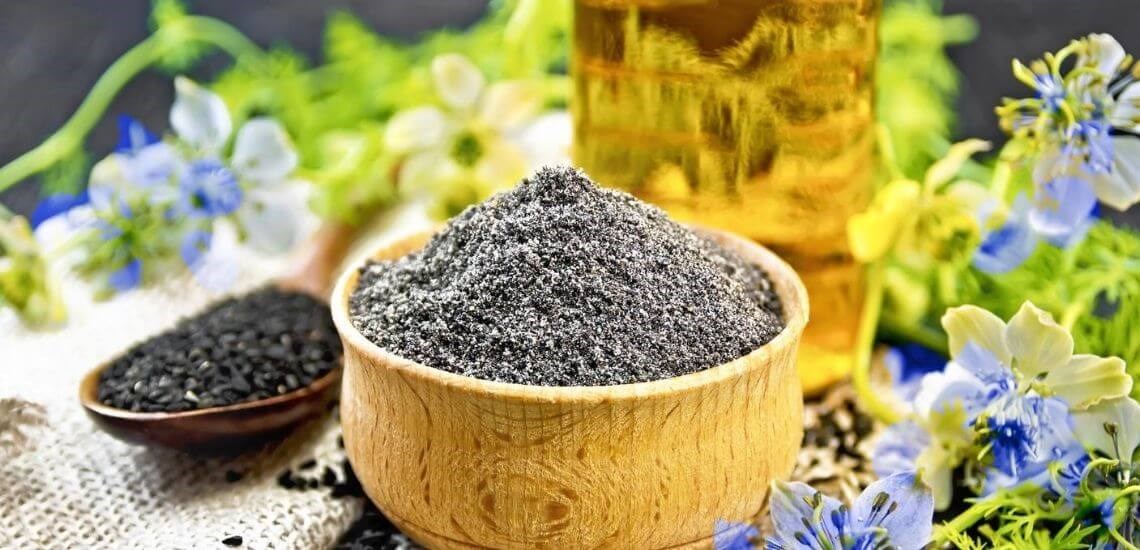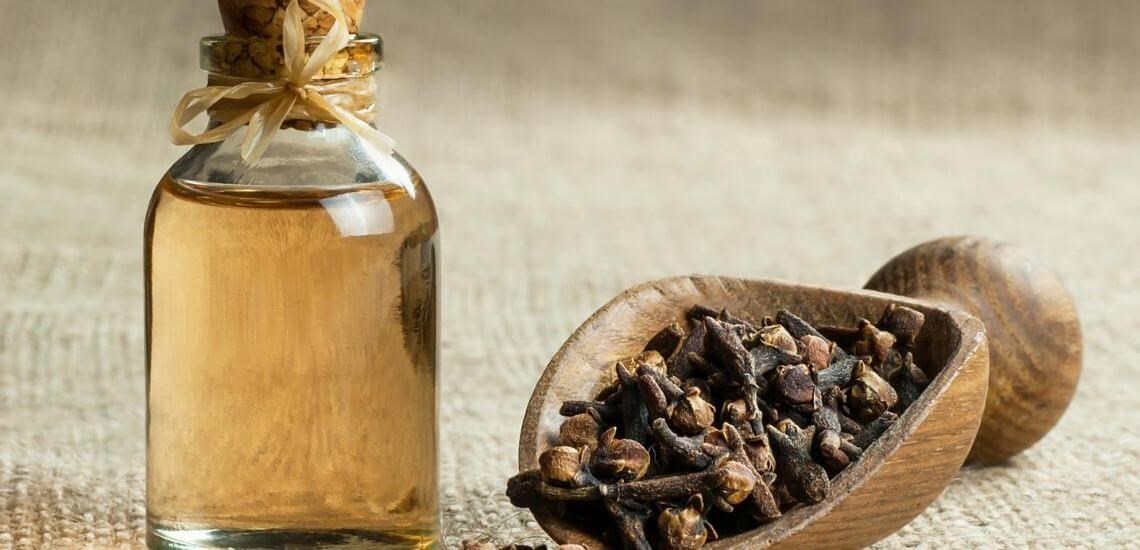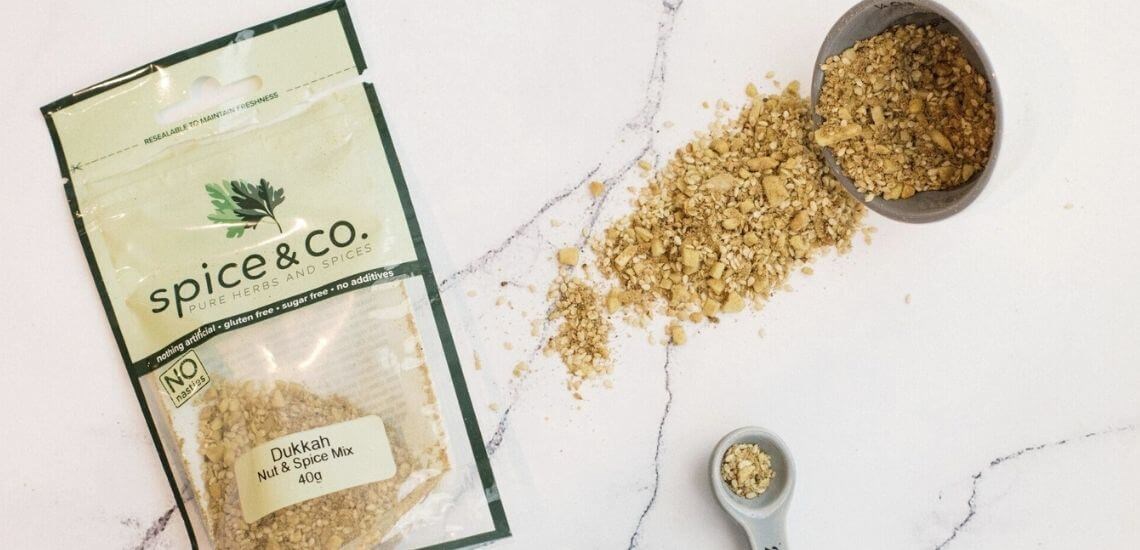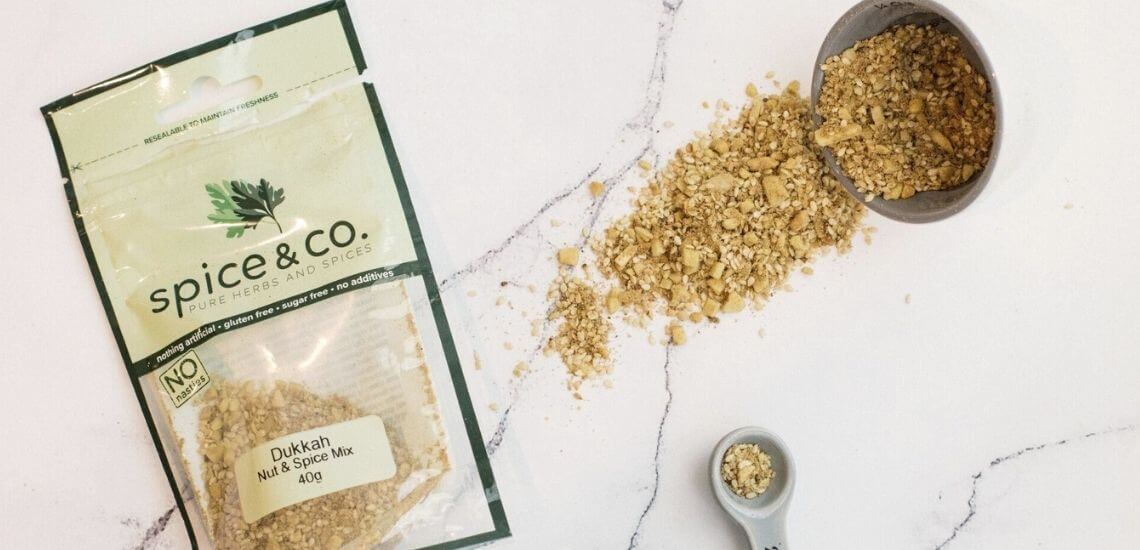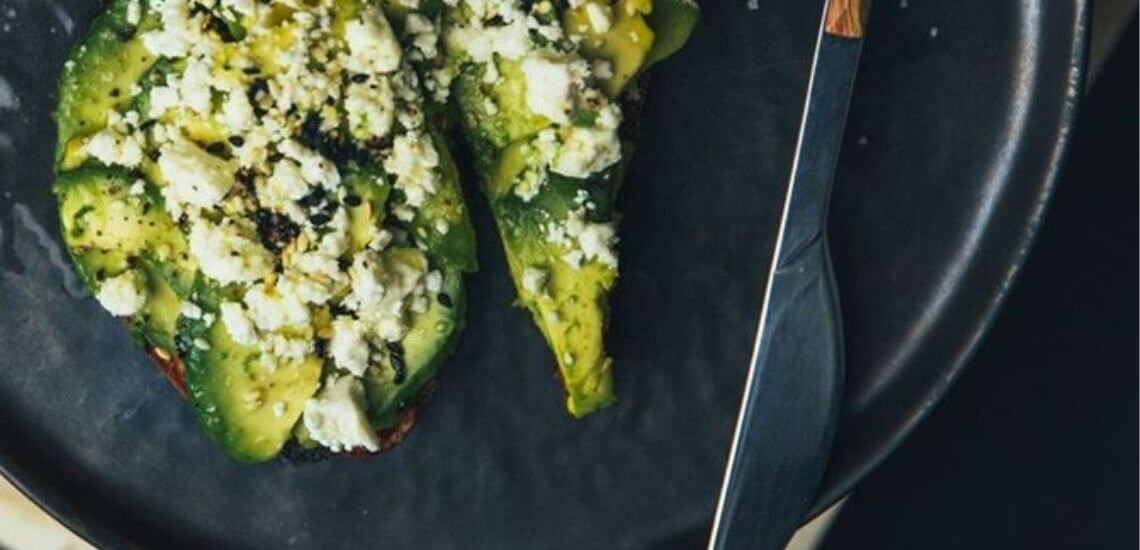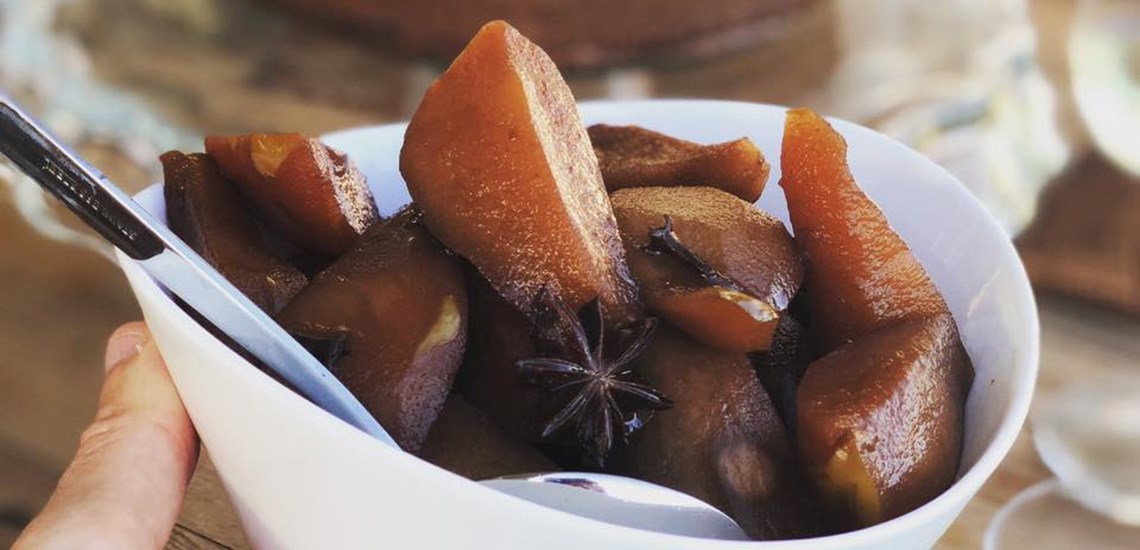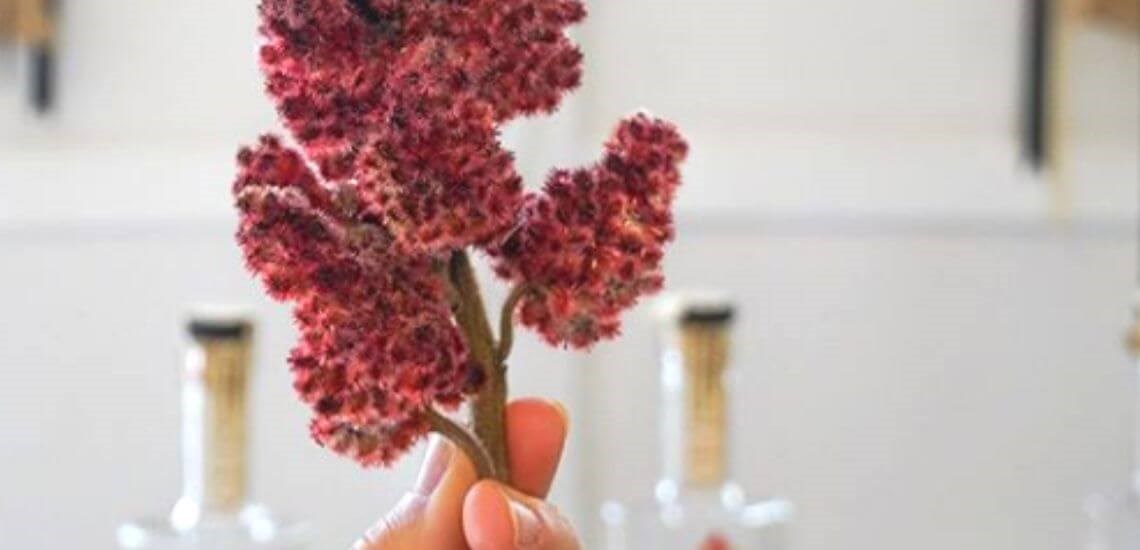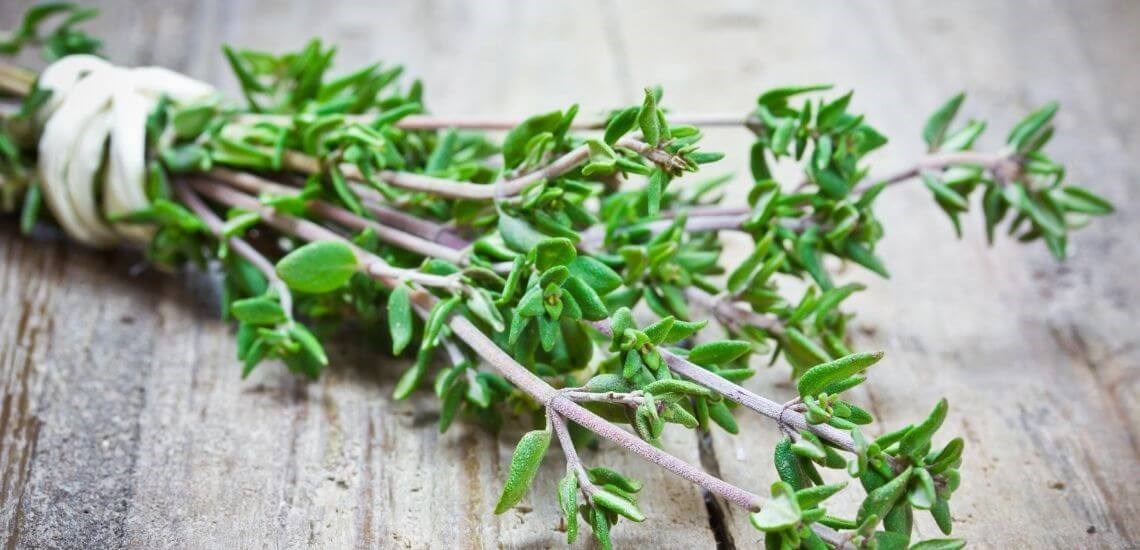Almost every day I’m throwing a spice or more into the meals I prepare, and it got me to thinking about how much spices remind me of places I’ve travelled. My travels have introduced me to new spices, or new ways to use them, and bringing these discoveries home are part of my travel memories.
My pantry is stacked with Spice and Co packets. I like them because they are pure herbs and spices; with no nasty fillers, they’re gluten and sugar free, and there’s nothing artificial. I also support them because like us, they’re 100% Australian owned. You may already know them from their Masterchef appearances, or your local grocer or deli. What they also do well is share ideas of easy ways to use spices in every day cooking.
Some of the spices I’ve included maybe one’s that we don’t use as much in Western countries but come high on my list of favourites. Two of regular ‘Go To’s’ are Sumac and Dukkah; these can be used very simply but bring the meal, or snack to a whole new level.
Spice and Co gave me the green light to share some of their spice insights and easy ways to use them.
Caraway Seeds
Caraway has an intense nut like aroma that combines the sweet flavours of anise, aniseed, fennel and mint. It is used in traditional continental style breads such as rye bread and is a key ingredient in barbecue style spice rubs and the fiery Tunisian spice paste, Harissa.
Uses and Ideas
- Crush the seeds, sauté in olive oil and add to carrots.
- Combine crushed caraway seeds with sea salt and cracked pepper - use as a dry rub/seasoning for roast pork belly, poultry or grilling steaks.
- Add to braised cabbage, sautéed leeks or caramelised onions.
- Add caraway seeds and mint to roast new potatoes
- Make a fragrant sweet potato dip by adding caraway and chilli to sautéed onion, add to well cooked sweet potato & puree with olive oil, sea salt and white ground pepper. Serve as a dip or reheat and serve with grilled fish, grilled poultry/duck, or steaks.
- Create a simple pasta of sautéed Chorizo, onion, caraway seed, and tomato - add pasta and top with fresh chopped herbs.
- Caraway also adds a unique flavour to baked/stewed fruits such as apples, quinces, pears & pineapple.
Roasted spuds sliced thin “a la hassleback” and roasted with olive oil. Choose your topping :
* Trad salt & pepper
* Sprinkled smoked paprika
* Roasted caraway seeds & Panko crumbs
* Garlic, lemon zest & sea salt
* Italian herbs
Cardamom
Cardamom is native to Western India and is intensely fragrant & aromatic. Its warm pungency contributes a "perfume" to curries, rice dishes, vegetable dishes, pickles and syrups. Use sparingly as it can be overpowering. Cardamom is also used in Indian & Middle Eastern beverages & breakfast pastries. Cardamom can be used to flavour ice creams, kulfi, fruit compotes such as pineapple, mango, apples, pear and bananas. In Arabian Cuisines Cardamom is one of the most popular spices. Cardamom coffee is a symbol of hospitality and prestige. One and a half teaspoons of ground cardamom is the equivalent of 10 cardamom pods.
Uses and Ideas
- Mix a little ground cardamom, ground cumin and parsley into breadcrumbs when crumbing lamb meatballs/cutlets.
- Score a fresh mango cheek in a trellis pattern - and dust with a mixture of ground cardamom/ brown sugar before flash grilling or torching - serve with vanilla ice cream.
- Add a pinch of ground cardamom and ground ginger to a stick date pudding recipe for a fragrant spicy variation.
- Add a little ground cardamom to a vanilla panna cotta, serve with pineapple compote scented with cassia quills.
A Gin Spritz with Cardamom Pods
A beautiful mix of blood orange, cardamom pods, sage leaves mixed with your favourite gin and a splash of Prosecco.
Cinnamon Sticks
Cinnamon "Sticks" are from the same family of trees as cinnamon cassia quills. Cinnamon "Sticks" are the dried bark of the an evergreen tree and have a more fragrant, floral aroma and are less pungent than cassia quills. Cinnamon Sticks are lighter in colour and more fragile than cassia quills. Both Cassia and Cinnamon Sticks are generally interchangeable in recipes - depending on your preference.
Uses and Ideas
- Add to cream-based preparations for ice-creams, semi-freddo, pana cotta, parfaits or cream brulee.
- Add with star anise to a Vietnamese beef pho (soup).
- Take a break from coffee or tea; a warm apple cider in a non-reactive pan - add one cinnamon stick and two allspice pimento berries. Gently heat until simmering, remove the allspice berries and pour the cider into mugs. Use the cinnamon sticks to garnish each mug.
- Add to Indian style vegetable dishes, rice pilaffs, biriyani.
- Add a cinnamon stick and split vanilla bean to poached stone fruits or sautéed diced apples to serve with pork.
Cloves Whole
Cloves are unopened tropical flower buds that originated in Indonesia. This highly aromatic spice has an intense flavour and should be used sparingly. Cloves should be used to impart flavour during the cooking process, but removed from dishes prior to serving as they retain their hard woody texture. They are key ingredient in (Indian) garam masala and (Chinese) five spice.
Uses and Ideas
- Add to curries, casseroles and béchamel (a white sauce simmered with a clove studded bay leaf and onion).
- Cloves go well with apples (apple pie), pickles and spiced (mulled) wines.
- Cloves are traditionally used to stud baked ham and are associated with festive baking.
- Braised Red Cabbage - Braise 1 finely sliced red cabbage in olive oil with 2 finely sliced Spanish onion, 2 grated apples, 6 cloves, 1 pinch of mace, 1 tbsp of red currant jelly and 1 tbsp of red wine vinegar. Add 1 tbsp of butter and slow braise for 80 minutes (stir occasionally). Season to taste and serve with roast duck, pork, game or quail.
Dill Leaf Tips
Dill leaves (tips) are native to Eastern Europe and the Eastern Mediterranean. The leaves have a delicate flavour of aniseed and lemon - hence dill is often paired with seafood dishes and sauces. Dill leaves are used in Scandinavian dishes for flavouring cured salmon (gravlax) traditionally served with a mustard and dill sauce. Dill is added to stuffed vine leaves in Greece, to cabbage and cauliflower dishes in Central Europe, and the dill pickled cucumbers of New York.
Uses and Ideas
- Add to scrambled eggs to serve with smoked salmon.
- Make a lemon vinaigrette, add chopped capers, anchovies and dill and spoon over just cooked seafood.
- Make a potato salad - whilst potatoes are still warm, add chopped onions (sautéed), mayonnaise, Dijon mustard, sea salt, freshly ground black pepper and dill.
- Add dill to sour cream or natural yoghurt, spoon over a fresh salad of cucumbers or sliced vine-ripened tomatoes or serve as a dip with water crackers.
- Add dill to sautéed potatoes, lentil or rice dishes.
Dukkah Egyptian Nut Mix
Dukkah is a nut, seed & spice mixture of Egyptian origin. Spice & Co. Dukkah combines toasted almonds, sesame seeds & spices.
Uses and Ideas
- Dukkah is traditionally served as a snack or at breakfast. As a snack (or with drinks) - serve the Dukkah in a small bowl alongside a small dish of extra virgin olive oil and bite sized pieces of grilled Turkish bread or sour dough. Dip bread in the oil, then coat in a thin layer of Dukkah, then enjoy.
- Sprinkle Dukkah with a little sea salt & extra virgin olive oil over hard or semi boiled eggs (quartered).
- "Dust'' Dukkah over cheese melts or oven dried tomatoes.
- Place a spoon of fork mashed avocado on grilled sour dough toast and sprinkle with Dukkah.
- Add Dukkah to fresh breadcrumbs and use to crumb chicken breasts, fish fillets, lamb cutlets or button mushrooms.
- Sprinkle on top your of your favourite dip e.g. Baba Ganoush/ Hummus.
- Make healthy crackers with flat bread, brush with olive oil and sprinkle with Dukkah- bake and break into pieces to serve with dips, meats and cheeses.
Nigella Seeds
Nigella is native to Western Asia. The seeds have a subtle herbaceous, peppery, and earthy nut like taste flavour. Nigella seeds are often incorrectly referred to as black onion seeds (but are from different plants). Nigella is most often used on Turkish Bread and flat breads throughout the Middle East and goes well with cauliflower and potatoes. Nigella is one of the five spices in Panch Phora which is used extensively in Indian cooking to enhance Dahls, add flavour and texture to curries and vegetable dishes. Due to their mild flavour nigella seeds can be used for visual appeal in couscous, rice dishes or potato salads.
Uses and Ideas
- Crush 1 tbsp nigella seeds with 1 tsp each coriander seeds and cumin seeds in a pestle and mortar and use for sautéed potatoes, zucchini, fennel, okra, spinach, onions, leeks, cauliflower, beans, and tomatoes.
- Make a pilaf using basmati rice with the addition of grated carrot and nigella seeds or add nigella to chickpeas braised with tomatoes.
- Toss crushed nigella seeds through a dice of roast root vegetables with a pinch of ground ginger, turmeric and allspice.
Nutmeg
Nutmeg is native to the spice islands of Indonesia. It is a warm intensely aromatic bitter/sweet spice that should be used sparingly as it can be overpowering in dishes. Nutmeg is used in Middle Eastern cuisine to add flavour to lamb dishes, in Italian cooking to add warmth to sauces for pasta, veal, sausages or spinach and in France for classically slow braised casseroles and ragouts. Ground nutmeg (as a fine powder) is often more suitable for baking and pastry applications and when used to "dust" over desserts such as baked custards.
Uses and Ideas
- Make a healthy mashed potato (chefs tip - use desiree potatoes) by using a combination of olive oil/butter or olive oil only. Add a small pinch of nutmeg when mixing.
- Add a pinch of nutmeg to pan-fried prawns or simple tomato sauces to serve with linguine, tagliatelle or penne.
- Add ground nutmeg to roast wedges of pumpkin, homemade pumpkin pie, pumpkin/date scones/muffins.
- Add a pinch of ground nutmeg to fennel and cheese gratins, light sauces finished with cream fraiche for chicken/veal or sautéed cabbage with bacon or speck.
- Use over a simple pasta w olive oil & salt
- Add to a béchamel or cheese sauce over cauliflower
- Add to wilted spinach with black cracked pepper and a splash of cream
Star Anise
Star Anise is native to Southern China and Vietnam and has an intense liquorice flavour/perfume and is the key ingredient of Chinese Five Spice. It is extensively used in Asian dishes and goes well with braised pork, duck, poultry and beef. Whole star anise is generally added to recipes during the cooking process and then removed prior to serving. Star anise is used in Chinese "red" cooking with cassia where the ingredients are simmered in a dark soy broth (Master Stock).
Uses and Ideas
- Use for poaching stone fruits, pineapple, rhubarb or pears.
- Crumble the star points. Add to Pork Spare Ribs marinades.
- Use to flavour sabayons, frozen parfaits or ice-cream.
- Vietnamese Beef Pho (Soup) - Combine diced onion with star anise, cassia quill, fennel, coriander seeds and strong beef stock. Simmer 20 mins - add fish sauce, palm sugar and salt to taste. Strain the broth and discard the spices etc. Place blanched (pre-soaked) thin rice noodles into serving bowls with finely sliced spring onions, sliced white onions, thinly sliced (raw) beef sirloin and boiled beef brisket (optional). Ladle over boiling beef stock. Serve with lime, bean sprouts, chilli & Hoisin sauce.
- Add to Asian style vegetable stir fries. Sichuan goes well with ginger, sesame, chillies, citrus, black beans, cassia and star anise.
Sumac Ground
Sumac is the fruit of a bushy shrub that is grown in the Middle East regions of Turkey and Iran and the Mediterranean region around Sicily. The fruit ripens in the form of conical clusters of berries that are sun dried and then crushed into a dark crimson/redish powder. In Middle Eastern cooking sumac is used as a souring agent (in place of lemon, tamarind or vinegar).
Uses and Ideas
- Sumac is delicious on roast meat and in particular lamb, when mixed with paprika, pepper and oregano.
- Sumac sprinkled on flat breads with olive oil before toasting.
- Use to garnish bowls of Middle eastern dips like hummus or minted Labna (drained natural sheep’s yoghurt).
- Sprinkle over a Greek salad with oregano or mix in with raw sweet onion/cucumber salad to serve with kebabs.
- Make a simple Fattoush salad by combining diced tomato, cucumber, radish, spring onions, torn mint and parsley, crispy broken pieces of toasted pita bread. Make a dressing with sumac, lemon juice/zest, olive oil, salt and pepper and pour over the well mixed salad.
Thyme
Thyme is a herb native to the Mediterranean and has small intensely aromatic leaves. Thyme has flavour/aroma that combines elements of allspice, clove, mint and pepper. Thyme is a key flavour component of bouquet Garni used in stocks and soups and French dishes like pot-au-feu to impart herbal richness.
Uses and Ideas
- Thyme is well suited to lamb - rubbed over seasoned lamb legs, cutlets, short loin chops, racks or sprinkled over lamb or beef meatballs/burgers or meat sauces/ragus.
- Add thyme to new potatoes and sauté in a little olive oil.
- Add thyme to a stuffing mixture for roast chicken.
- Sprinkle over foccacia with a drizzle of olive oil, top with crumbled goat cheese, diced chorizo, olives and grill.
- Use thyme when sautéing onions or button mushrooms.
- Add thyme to Mediterranean style white bean soups, gumbos or one pot dishes requiring a spike of flavour.
- Add thyme to red wine marinades for cheaper cuts of red meats like skirt steak, flank steak, rump or beef ribs.
- Add thyme to braised dishes using beef cheeks or lamb shanks with rich stocks and market
These are just some of the ideas, but if you’re keen for a library of ideas, visit their spice info page for the whole list.
Find out More About Spice & Co
These are just some of the ideas, but if you’re keen for a library of ideas, visit their spice info page for the whole list. You can follow Spice & Co on Facebook and find more of their easy to follow recipe ideas.

5 nights on Fraser Island

